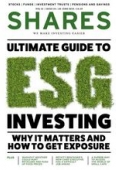Archived article
Please note that tax, investment, pension and ISA rules can change and the information and any views contained in this article may now be inaccurate.
ETFs to gain exposure to the US, Europe and China

While there are many compelling opportunities for investors in companies on the UK stock market, there is a whole world of opportunity out there for people to make money.
And more importantly, investing in companies in other countries can provide important portfolio diversification benefits, particularly as a domestic-focused firm on the other side of the world is rather unlikely to be affected by Brexit, for example, and the whims of British politicians.
It’s not always easy to directly invest in companies in other countries, and in some cases it’s impossible. That’s where investment funds come to the rescue. They provide instant diversification and give you access to different geographic markets at the click of a button.
Many of these funds overcome the hurdles about foreign ownership of stocks and there is rarely the form-filling you often get when investing in individual companies listed on overseas exchanges.
TWO PATHS TO TAKE
Investors have two main choices to get geographic exposure – either buy an actively-managed fund where someone is picking stocks or other assets to go into a portfolio, or buy a passive fund which simply tracks the performance of a specific index.
In the latter case, the index will have specific rules to determine which stocks and/or other assets qualify for inclusion. Costs for passive funds tend to be much lower than active funds because the index is essentially maintained by computers and there isn’t an expensive fund manager salary to pay.
We see merit in considering both strategies. On one hand there are some very good fund managers with the skills to outperform the market. On the other hand, passive products do help to keep your costs down – which really matters in investing – and they provide simple, easy access to a broad range of assets.
For this article we’re going to focus on the passive side and explore the range of exchange-traded funds (ETFs) offering exposure to three different geographic markets.
ETFS TO PLAY THE US
It can be hard to beat a market over a long period which makes it a fairly easy choice to buy a fund which tracks the whole thing.
While there will always be some savvy stock pickers who happen to beat the market in any one year, even the legendary Warren Buffett has conceded he most likely can’t outperform the US S&P 500 index in the long-term.
Indeed, a study earlier this year from S&P Dow Jones Indices revealed that 64% of active US large cap funds underperformed the S&P 500 in 2018.
Over 10 years, 85% of such funds underperformed compared to the index, and over 15 years the figure rose to almost 92%.
So at a time when the outlook for the US economy over the next few years is considered to be better than most other developed countries, a great way to play the US market is through an ETF.
AJ Bell’s head of passive portfolios Matt Brennan says: ‘US financial markets have always been 10 to 15 years ahead of everywhere else, and even active managers now understand that it is really hard to beat the US market, as there is a lot of information out there and it is so efficient.’
THE ISHARES ETF
Brennan flags iShares Core S&P 500 (CSP1) and says its size and its low price, particularly when taking into account dealing charges, make it a standout candidate.
While its headline 0.07% fee is marginally higher than others on the market, it has significantly lower dealing charges and bid/offer spread, bringing the overall fee down compared to other ETFs which also track the US market.
Some of the names being tracked by the index include Microsoft, Apple, Amazon and Warren Buffett’s investment vehicle Berkshire Hathaway.
OTHER ETFS
If you want to look further down the market cap spectrum, among the ETFs tracking the Russell 2000 small-cap index in the US is Lyxor Russell 2000 ETF (RUS2) with a 0.19% ongoing cost.
ETS TO PLAY EUROPE
European economies have had a tough time recently, having been singled out as the global laggards when it comes to growth.
Proclamations of doom were made at the start of the year, when fears grew that the euro area could be heading for a recession.
And while there have been shocks and various little nasties from unexpected slowdowns and trade tensions, things may be about to turn.
According to Amundi strategist and economist Tristan Perrier, some of the factors that were ‘highly negative’ in 2018 are only temporary and are likely to fade.
For starters, the German auto industry is expected to pick up again as the year continues, while people in France should be spending more again as the gilets jaunes protests start to wane.
Across Europe, Perrier adds that household income in recent months has been on a ‘steep upward trajectory’, with the amount of cash people have in their pockets this year expected to be even better as inflation goes down.
He also points out that even as bad news was piling up on GDP and other economic indicators, the unemployment rate in the Eurozone kept declining, to 7.8% in January 2019 from 8.6% a year earlier.
In addition, Perrier says employment has remained strong, and most importantly, wages rose by about another 2% last year.
He adds: ‘All of these figures should mean an increase in real household consumption far above last year’s 1.2%, while year-on-year inflation recedes rapidly under the base effects of energy prices (even when assuming a slight increase in oil prices this year).’
There are risks, particularly around Brexit and persistent threats of tariffs on exports of European vehicles, as well as the continuing populist movement across the continent. But from an economic point of view the clouds appear to be lifting in Europe.
THE AMUNDI ETF
One way to play the turning tide of Eurozone growth is Amundi Prime Eurozone (PRIZ).
The ETF aims to replicate the performance of the Solactive Euro 50 index, a benchmark which follows the 50 largest companies in 10 Eurozone countries.
It has an ongoing charges figure of just 0.05%, which is better than most other similar ETFs on the market, and provides exposure to some of the biggest and well-known companies in Europe like Siemens, Unilever (ULVR), Airbus and Santander.
OTHER ETFS
Further products offering exposure to the Eurozone territory include Vanguard FTSE Developed Europe ex-UK ETF (VERX) which tracks an index of large and mid-cap stocks in such countries as France and Germany. It charges 0.12%.
ETFS TO PLAY CHINA
Now could be the time to take the plunge and invest in China’s growth story as the country has become more accommodating to foreign investors.
In a two-stage process which began in June last year, over 200 large cap Chinese companies on both the Shanghai and Shenzhen stock exchanges have been added to the MSCI Emerging Market and ACWI indices, two globally accepted investment indices.
Companies trading on these Chinese stock exchanges are known as A-shares, and unlike companies on the Hong Kong Stock Exchange which overseas investors have always been able to buy, they are considered more representative of the Chinese economy as they are a lot more domestically focused.
And given their inclusion in the aforementioned indices, overseas investors are now able to invest in them, albeit only via investment funds due to Chinese government regulation.
THE LXYOR ETF
One way to access China A-shares is Lyxor Hwabao WP MSCI China A ETF (CNAA) which charges 0.65%. Adam Laird, Lyxor’s head of ETF strategy for Northern Europe, says the country is a ‘high performing area’, which provides good opportunity for investors as ordinary people in the world’s most populous country continue to get richer.
He adds: ‘The big story about China is that factor of opening up. Everyone’s seen over the last decade or longer how much of a role China is playing in the global economy.
‘There’s a lot of opportunity. You’ve got some domestic companies in China that have a larger consumer base than big multinationals because of the size of the population there.’
The Lyxor ETF tracks the MSCI China A Net Total Return index which captures Chinese large and mid-cap A-shares listed on the Shanghai and Shenzhen exchanges. It covers only those securities accessible through the ‘Stock Connect’ link between China’s mainland markets and the Hong Kong Stock Exchange.
OTHER ETFS
Another way of getting access to China is Xtrackers CSI 300 Swap ETF (XCHA). It tracks the CSI 300 index which covers the 300 largest and most liquid A-share stocks.
The ETF is synthetically replicating an index of Chinese stocks rather than physically owning the underlying shares.
Synthetic ETFs use derivatives such as swaps to track the underlying index. This process can be difficult to understand and many investors stay clear of such ETFs as they don’t like the idea that the product doesn’t physically own the assets.
However, the Xtrackers ETF has significantly outperformed the Lyxor ETF since the start of 2017, generating nearly 26% total return versus 3.1% respectively.
Important information:
These articles are provided by Shares magazine which is published by AJ Bell Media, a part of AJ Bell. Shares is not written by AJ Bell.
Shares is provided for your general information and use and is not a personal recommendation to invest. It is not intended to be relied upon by you in making or not making any investment decisions. The investments referred to in these articles will not be suitable for all investors. If in doubt please seek appropriate independent financial advice.
Investors acting on the information in these articles do so at their own risk and AJ Bell Media and its staff do not accept liability for losses suffered by investors as a result of their investment decisions.

 magazine
magazine











